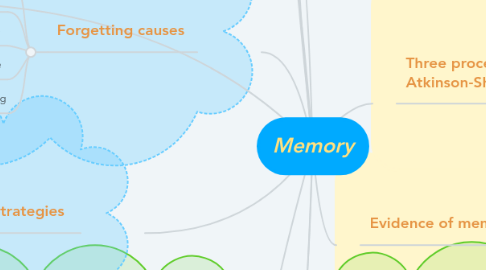Memory
da HALAH ABDULRAHMAN


1. Persistence of learning over time through the encoding, storage, and retrieval of information
2. Atkinson-Shiffrin model updated concepts
2.1. Working memory, to stress the active processing occurring in the second memory stage
2.2. Automatic processing, to address the processing of information outside of conscious awareness
3. Sensory memory
3.1. First stage in forming explicit memories Immediate, very brief recording of sensory information in the memory system
4. Short-term memory
4.1. Activated memory that holds a few items briefly (such as the seven digits of a phone number while dialing) before the information is stored or forgotten
5. Effortful Processing Strategies
5.1. Chunking
5.2. Mnemonics
5.3. Hierarchies
5.4. Spacing effect
6. Memory Retrieval Cues
6.1. Priming
6.1.1. Activation, often unconsciously, of particular associations in memory
6.2. Context-dependent memory
6.2.1. Involves improved recall of specific information when the context present at encoding and retrieval are the same
6.3. State-dependent memory
6.3.1. Involves tendency to recall events consistent with current good or bad mood (mood-congruent memory)
6.4. Serial position effect
6.4.1. Involves tendency to recall best the last (recency effect) and first (primacy effect) items in a list

